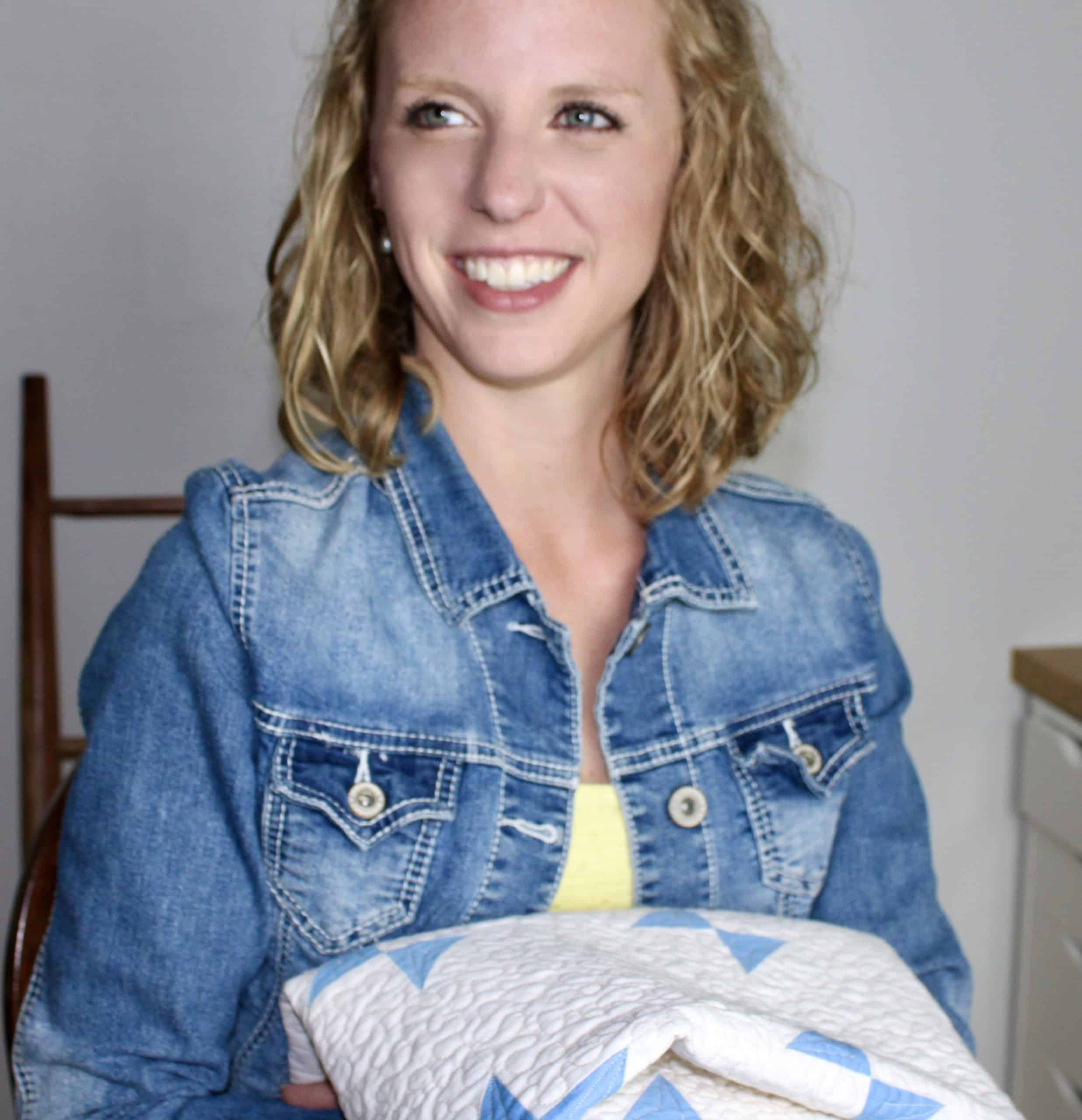Free motion quilting has a bad reputation for having a steep learning curve.
It is a very different way to use your sewing machine that puts you in complete control removing all of the failsafes that we are used to helping us through a project.
While this can always seem a bit like doing the tight rope walk without a net to catch you, it also gives you the freedom to create any design you like without any restrictions.
Trying something new that can add a level of risk to the quality of your quilt can be a scary transition that many quilters simply avoid altogether.
However free motion quilting can give you a level of detail to your quilts that you simply can’t achieve with just a walking foot.
Today I’m debunking some common free motion quilting myths that cause quilters to avoid even trying. By understanding what’s causing the hesitancy to begin with, we can figure out a solution and develop the confidence you need to try something new!

They think they need 20+ years of quilting experience to be good at it
The biggest free motion quilting myth you’ll hear is that if you don’t have decades of experience quilting, then there is no point in attempting. Many of those people you look up to when it comes to quilting skills have lots and lots of years of experience so it MUST be a waiting game. That the more quilts you make, the better your free motion quilting will be.
And that is totally true, but only if you actually practice your free motion quilting on those quilts. The more practice you get at FMQ, the better your skills will be. That means the more quilts you make, the more opportunities you have to practice!
Bravery is definitely a piece of this that you will have to face. Many quilters are so hesitant to “mess up” their quilts with “bad” free motion quilting that they simply avoid it instead. But you will have to take the leap of faith and trust yourself to do what you always do and make a beautiful quilt, no matter how many mistakes you think you’ve made.
You think you need to be an artist to be good at it

When you are picking out a pattern, you aren’t designing it by hand, someone else has already done the graphic design work for you, all you need to do is follow the directions. In machine quilting there is an element of drawing that can often look wildly different depending on who is drawing it.
Since you are creating something out of nothing, it often feels as though you need to be an artist to be able to stitch the designs well.
However, for this free motion quilting myth, the truth is actually much different.
Free motion quilting is far more similar to writing than it is drawing.
If you can actively write your name on a piece of paper in different ways, you can learn to free motion quilt. No drawing skills required.
If you can actively make yourself write neater, or in cursive, you can actively train yourself to free motion quilt in better/different ways. All it takes is focusing on what you do and don’t like about the way you are currently making your designs and experiment with different things.
If I can stitch it perfectly on a swatch, I’ll stitch it perfectly on the quilt

This one isn’t so much a free motion quilting myth as it is a harsh realization if you aren’t prepared for it.
The curve ball that many quilters give up on is the transition between a practice swatch and a real quilt. Many people think that if they can master the design in practice that they are finally ready to try it on a real quilt.
What happens is they aren’t prepared for the extra factors that come in when you add the weight, bulk, and size of a real quilt. The quilt starts to fight back and the design ends up looking more like those beginning sloppier version of the design instead of your perfectly polished version you know you can make on the swatch.
A corner appears where it shouldn’t be because you ran out of throat space, or you get uneven stitches and you realize there is more than one learning curve.
One to learn the design, a second to manage the quilt.
And then it hits you, you feel like you have to learn the design all over again.
Many quilters get so discouraged by this realization that they pack everything up and avoid free motion quilting instead.
Knowing there are two learning curves to FMQ is the key to tackling this confidence killer head on. When you are surprised by it, it can cause a ton of frustration because you think you’ve climbed the hill. You think you’ve got it, and then it knocks you back down.
But if you know to expect the added challenge from the start, you’ll be far less likely to get that deflated feeling of quilting defeat. Instead you’ll see it coming and notice those factors that are affect your quilting much sooner. It’ll give you a better outcome and help you maintain your motivation to learn how to manage the new challenges instead of giving up.
Learning the designs is the hardest part

The throat space is too small to wrestle the quilt through, it’s falling off the table in the back AND the front, pieces are folding under that get caught under the needle, you need to know where you are going at all times, AND you need to perfectly coordinate your feet and hands? I’m exhausted just thinking about it!
Quilting on a domestic machine has its own challenges for sure, but no matter what machine you are quilting on, you’ll find yourself with so many things pulling for your attention, that it’s often feels like you have to climb a mountain before even starting to stitch.
Of all of the free motion quilting myths on this list, this one is the easiest to tackle. The answer?
Automate as much as possible.
Find a bigger table, mark your designs (even if its by hand), and stop often to rearrange your quilt as you move.
It’s not about being “good” at free motion quilting, it’s about out-smarting the quilt and beating it at it’s own game.
You don’t need to figure out how to multitask all of them when you can simply remove tasks from the list to manage.
Related:
What is FMQ, how to get started and tips for mastering it FAST
7 Hacks for Free Motion Quilting
You’ll Never Compare to a Computerized Sewing Machine

Have you SEEN those beautiful pantographs? Perfectly spaced, lines straight as an arrow, and not a single stitch missed. How can we possible compare?
In short, we don’t do a comparison at all, because it’s apples to oranges.
The free motion quilting myth debunk here is that just because a computer can print a picture clearer than a person can paint one, doesn’t make the computer printed one more valuable.
Your quilts are uniquely yours, and while you should definitely set yourself goals, and strive to improve areas and designs you would like to get stronger in, you are not a computer.
Getting discouraged because your quilting isn’t as consistent as a computers is only encouraging thoughts of “I’ll never be that good”.
Instead, compare yourself now to your previous quilts. Focus more on how much you’ve improved as opposed to how far you think you still have to go.
When you hold two quilts up next to each other and realize how amazing your quilting looks now compared to your first couple attempts, you’ll undoubtedly continue to feel motivated to keep practicing.
You always have straight line quilting to fall back on
I’m going to preface this one with this: there is absolutely nothing wrong with having a go-to quick and easy design.
Not every quilt calls for free motion quilting and sometimes you just don’t have the time or desire for anything fancy. And that is okay.
But when you have a quilt you spent a lot of time piecing, you aren’t in a rush to get it finished, and its just calling for a free motion design, don’t default to the go-to just to avoid potentially “ruining” it.
My favorite part about practicing quilting on your real quilts, is that you have significantly more motivation to get it right!
You’ll be far more critical about how your designs are quilting out and more observant as you are quilting it which means you can change up your technique on the fly.
Didn’t go so good on the last block? You’ll naturally want to do it better on the next block and find yourself adjusting things to make it better.
You’ll have more space to practice the same design and really nail it down perfect by the end.
So next time you find yourself reaching back for that go-to design, just jump in with both feet and commit to that fancier version that you are day dreaming about.
You’ll never be able to choose the right designs for the right spots

Where on earth do you even start. What’s the easiest design, how do I quilt it, where do I use it afterward, and how am I supposed to pair designs that look good together?
Probably the biggest free motion quilting myth on this list: you don’t actually have to commit to a custom free motion quilting designs to get started with free motion quilting.
Using a pantograph style quilting design is a great way to dip your toes in to the free motion quilting game without committing to a full custom design.
A pantograph is an all over pattern that ignores the piecing of the quilt top. It repeats the pattern in rows across the quilt and when you quilt multiple rows you’ll get an all over texture, similar to the straight line quilting but, with more interest.
I like starting with pantographs for a few reasons:
- Half the battle of custom designs is deciding WHAT to quilt before you even learn HOW. Since pantographs ignore the quilt top piecing, you don’t have to decide on whats going to go where which simplifies the process. Just get used to stitching with free motion before complicating it with different designs.
- To get consistent spacing, it’s best to mark out your pantograph before getting started. Although it keeps your shapes on track, it also forces you to automate one of the hardest things to multitask when FMQ: always knowing where to go. Just follow your line, and you’re good to go.
- Many basic pantographs can be completed by either a walking foot OR a free motion foot. If you find after a row or two the free motion foot isn’t really working out, you always have the option to switch out to your walking foot to finish the rest, WITHOUT ripping stitches and starting from scratch. This is a great way to practice free motion quilting with low risk to your finished quilt!
I found myself using the same pantograph design so often that I decided to create a simple pantograph quilting template to make it easy to mark out as many times as I liked. I figured that if I used it all the time, then you might like them too!
Be sure to click here to grab a downloadable copy of the template FOR FREE!
Being good at free motion quilting takes time and practice, so challenge yourself to tackle it head on and I’ll be cheering you on every step of the way!









0 Comments